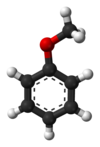Anisole
|
|
|||
| Names | |||
|---|---|---|---|
|
Preferred IUPAC name
Anisole
|
|||
|
Systematic IUPAC name
Methoxybenzene
|
|||
| Other names
Methyl Phenyl ether
Phenoxymethane |
|||
| Identifiers | |||
|
100-66-3 |
|||
| 3D model (Jmol) | Interactive image | ||
| ChEBI |
CHEBI:16579 |
||
| ChEMBL |
ChEMBL278024 |
||
| ChemSpider |
7238 |
||
| ECHA InfoCard | 100.002.615 | ||
| KEGG |
C01403 |
||
| UNII |
B3W693GAZH |
||
|
|||
|
|||
| Properties | |||
| C7H8O | |||
| Molar mass | 108.14 g·mol−1 | ||
| Appearance | Colorless liquid | ||
| Density | 0.995 g/cm3 | ||
| Melting point | −37 °C (−35 °F; 236 K) | ||
| Boiling point | 154 °C (309 °F; 427 K) | ||
| Solubility | Insoluble | ||
| -72.79·10−6 cm3/mol | |||
| Hazards | |||
| NFPA 704 | |||
| Lethal dose or concentration (LD, LC): | |||
|
LD50 (median dose)
|
3700 mg/kg (rat, oral) | ||
|
Except where otherwise noted, data are given for materials in their standard state (at 25 °C [77 °F], 100 kPa).
|
|||
|
|
|||
| Infobox references | |||
Anisole, or methoxybenzene, is an organic compound with the formula CH3OC6H5. It is a colorless liquid with a smell reminiscent of anise seed, and in fact many of its derivatives are found in natural and artificial fragrances. The compound is mainly made synthetically and is a precursor to other synthetic compounds. It is an ether.
Anisole undergoes electrophilic aromatic substitution reaction more quickly than does benzene, which in turn reacts more quickly than nitrobenzene. The methoxy group is an ortho/para directing group, which means that electrophilic substitution preferentially occurs at these three sites. The enhanced nucleophilicity of anisole vs benzene reflects the influence of the methoxy group, which renders the ring more electron-rich. The methoxy group strongly affects the pi cloud of the ring as a mesomeric electron donor, more so than as an inductive electron withdrawing group despite the electronegativity of the oxygen.
Illustrative of its nucleophilicity, anisole reacts with acetic anhydride to give 4-methoxyacetophenone:
Unlike most acetophenones, but reflecting the influence of the methoxy group, methoxyacetophenone undergoes a second acetylation. Many related reactions have been demonstrated. For example, P4S10 converts anisole to Lawesson's reagent, [(CH3OC6H4)PS2]2.
...
Wikipedia



